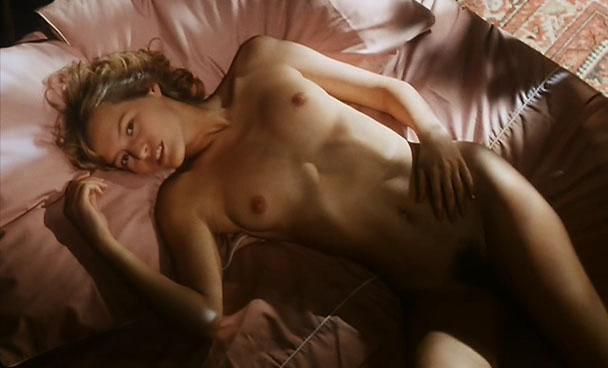“Do you know, sir, that most of the people you see in the street are dead? That’s why it’s crowded everywhere. And to avoid making a fuss they dress like us.”
Pretty-looking Daniel Mesguich (of Truffaut’s Love on the Run and a mid-70’s Kafka movie) works for motorcycle-drivin’ Cyrielle Clair (Tusk, Triple Agent). Goes off on an assignment one day but the client turns up dead and Daniel gets himself mixed up with Inspector Daniel Emilfork (the dream-snatcher in City of Lost Children) and often-nude vampire ghost Gabrielle Lazure. Movie gets increasingly dreamlike and plot gets increasingly Twilight-Zone-ish, guy starts seeing himself executed at the order of his boss, then he wakes up next to his wife (the boss). It was all a dream! But he’s still stuck in it, sees the girl again, gets executed again, etc.
“The angel of death. Nobody can guess what it looks like. And when you see it for the first time you can’t tell. It has a sweet and caring face. But when you know what’s behind it, it’s already too late.”
The two Daniels. Left: our sleepy-eyed hero in his just-pressed coat, right: mad scientist Emilfork gleefully presenting the Bunuelian shoe/foot motif that will run throughout the film.

Our vampire, looking a little tired.

The angel of death, aka our hero’s wife/boss.

I liked the Schubert music a lot. Cinematographer Henri Alekan shot Wenders’s Wings of Desire and Cocteau’s Beauty and the Beast. For the most part, movie looked very good, though the dreamy artificiality and theatrical lighting gave it a made-for-TV look at times. Came out the same year as Sans Soleil, Stranger Than Paradise, Resnais’s Life is a Bed of Roses.
Seems that Robbe-Grillet’s lofty ambitions for a new cinema were let down by his own limitations as a filmmaker – the sets and costumes look cheap, and the low-rent actors don’t give the movie enough energy. Sometimes, like one moment when the screen fills with horrid video effects, you feel that it looks cheap on purpose, that it’s some weird French commentary on cheap-looking movies. And if it’s all a dream, it’d make sense that the actors are sleepwalking. Found a great article online by J. Clark explaining more about the author, his inspirations (movie is based very loosely on his own novel, almost a sequel to it, in posthumous “collaboration” with the painter Magritte) and collaborators and failures. Clark also makes some Twilight Zone comparisons. But I don’t want to beat up on it too much. Alain R-G might not have created a masterpiece, but the movie was cool and worth watching – for the tableaus, the nudity, the atmosphere, the moments of WTF acting/story/imagery. Witness below.
The aforementioned nudity.

Along with more footwear, our hero finds the source novel in a cabinet.

A Magritte original (?)

A Robbe-Grillet original (?)

Firing squad on the beach

One goofy actress.

Some kinda Terry Gilliam greenscreen/video lunacy takes over for a minute.

Sight & Sound explained:
“It shares its title and intent with his 1975 experimental novel, co-credited to surrealist painter René Magritte, which reworked texts originally written for two earlier novels, Topologie d’une cité fantôme and Souvenirs du triangle d’or, into a new narrative, illustrated by 77 Magritte paintings reproduced in black and white. Whereas the book could be read as a dialogue between Magritte’s surrealist canvases and the author’s imagination, the film tells a different story, in which Magritte’s paintings also figure, though not exclusively: Goethe’s telling of the Greek legend of the Bride of Corinth and Manet’s The Execution of Maximilian also intrude into its dream weaving, as does Jean Cocteau’s depiction of the Angel of Death as a motorcyclist in Orphée, an earlier work of cinematographer Henri Alekan.”
B. Stoltzfus:
“What characterizes [Magritte’s] La Belle captive series of paintings is the undecidability of the image. Each one of the six canvases contains an easel that holds a painting within a painting, a procedure that establishes specular duplication with mise-en-abyme effects. The painting on the easel replicates the landscape beyond it and the internal frame breaks the continuity of the image while accentuating it. Although the background and the foreground overlap, the perspective is impossible. Is the canvas transparent or opaque? Are we looking through it at images in the distance or are these images in front of us. This ambiguity sets up a visual paradox that cannot be resolved and the undecidability of the perspective elicits epistemological and ontological concerns in the mind of the observer.”
J Clark:
Explanation: “The world of his novels and films eschews plot and conventionally ‘well-developed’ characters in favor of recurring images of surfaces and objects, which his narrators incessantly catalog almost everything around them.” Sounds almost Greenaway-esque.
Judgement: “Cumulatively, this is a failure of Robbe-Grillet providing himself with the essential materials of his art: performance, image, sound, design. Instead of transforming the real world into something enigmatic, as he does in his novels or in Last Year at Marienbad, everything just looks ordinary, under-dressed, and with no resonance. Although Robbe-Grillet seems to be going for an interesting amalgam of pop culture (film noir, vampire movies) and high art (the New Novel aesthetic), neither is realized with sufficient depth.”
And my favorite single-sentence summary: “Robbe-Grillet transgresses ‘realistic’ narrative by eliminating character, story, and chronology.”
Ouch, this just in, Aug 2008 from A. Tracy at Moving Image Source:
“To discover Robbe-Grillet for the first time… is simply to uncover yet another little niche of world cinema: not uninteresting, more than a little entertaining, and entirely removed from that grandness of intention that even the most jaded cinephiles secretly thrill to.”